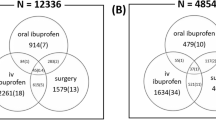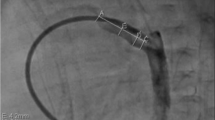Abstract
Objective:
The decision to perform patent ductus arteriosus (PDA) ligation is controversial. Patient selection is oftentimes poorly standardized, leading to delays in referral and inappropriate intervention. A system for PDA ligation categorization and triaging process was introduced in 2006 at a quaternary hospital in Canada to streamline referrals and enhance perioperative care. We aimed to evaluate the impact of this dedicated PDA ligation triaging system comparing pre- and postimplementation of this system.
Study Design:
We performed a retrospective chart review. Demographic and cardiorespiratory data of neonates ⩽30 weeks gestation age at birth, who were referred for and/or had a PDA ligation performed during two distinct epochs (EPOCH 1 (2003 to 2005) and EPOCH 2 (2010 to 2012)), were analyzed. All surgeries were performed at The Hospital for Sick Children, the regional referral center for PDA ligation. The primary outcome was incidence of PDA ligation and procedural cancellations. Secondary outcomes included postoperative need for cardiovascular or respiratory support. Subgroup analysis was performed in neonates <1000 vs >1000 g at the time of surgery during both epochs.
Result:
A total of 198 neonates underwent surgery with no difference in baseline demographics between epochs. The incidence of PDA ligation as a proportion of total live births under 30 weeks in Central East Region of Ontario was lower in the second epoch (EPOCH 1: 117/1092 (10.7%) vs EPOCH 2: 81/1520 (5.3%)). During the second epoch, 24% of referrals for surgery were canceled after review by our PDA ligation team. There were no overall differences in the proportion of neonates with oxygenation failure, ventilation failure or Post-Ligation Cardiac Syndrome (PLCS), after surgery, between epochs. The proportion of neonates who developed systemic hypotension was higher in patients <1000 g (n=34 (34%) vs n=17 (17.4%), P=0.01) at the time of surgery. In addition, we identified a reduction in the proportion of neonates <1000 g who developed PLCS in EPOCH 2. On the contrary, there was an increase in the proportion of neonates >1000 g who developed ventilation failure in EPOCH 2.
Conclusion:
The presence of dedicated triaging and management system enhances efficiency of referral process through careful selection of patients for PDA ligation and optimizes perioperative management. We demonstrated a reduction in the incidence of PDA ligation without any negative impact on short-term neonatal morbidity. The use of targeted neonatal echocardiography in the assessment of PDA shunt volume and guiding postoperative decision making is likely to have contributed to these findings.
This is a preview of subscription content, access via your institution
Access options
Subscribe to this journal
Receive 12 print issues and online access
$259.00 per year
only $21.58 per issue
Buy this article
- Purchase on Springer Link
- Instant access to full article PDF
Prices may be subject to local taxes which are calculated during checkout

Similar content being viewed by others
References
Van Overmeire B, Chemtob S . The pharmacologic closure of the patent ductus arteriousus. Semin Fetal Neonatal Med 2005; 10 (2): 177–184.
Wyllie J . Treatment of patent ductus arteriosus. Semin Neonatol 2003; 8 (6): 425–432.
Ohlsson A, Walia R, Shah SS . Ibuprofen for the treatment of patent ductus arteriosus in preterm and/or low birth weight infants. Cochrane Database Syst Rev 2010; (4): CD003481.
Allegaert K, Anderson B, Simons S, van Overmeire B . Paracetamol to induce ductus arteriosus closure: is it valid? Arch Dis Child 2013; 98 (6): 462–466.
Clyman RI, Couto J, Murphy GM . Patent ductus arteriosus: are current neonatal treatment options better or worse than no treatment at all? Semin Perinatol 2012; 36 (2): 123–129.
Clement WA, El-Hakim H, Phillipos EZ, Cote JJ . Unilateral vocal cord paralysis following patent ductus arteriosus ligation in extremely low-birth-weight infants. Arch Otolaryngol Head Neck Surg 2008; 134 (1): 28–33.
Roclawski M, Pankowski R, Smoczynski A, Ceynowa M, Kloc W, Wasilewski W et al. Secondary scoliosis after thoracotomy in patients with aortic coarctation and patent ductus arteriosus. Stud Health Technol Inform 2012; 176: 43–46.
Gould DS, Montenegro LM, Gaynor JW, Lacy SP, Ittenbach R, Stephens P et al. A comparison of on-site and off-site patent ductus arteriosus ligation in premature infants. Pediatrics 2003; 112 (6, Part 1): 1298–1301.
Dollberg S, Lusky A, Reichman B . Patent ductus arteriosus, indomethacin and necrotizing enterocolitis in very low birth weight infants: a population-based study. J Pediatr Gastroenterol Nutr 2005; 40 (2): 184–188.
Evans N, Kluckow M . Early ductal shunting and intraventricular haemorrhage in ventilated preterm infants. Arch Dis Child Fetal Neonatal Ed 1996; 75 (3): F183–F186.
Marshall DD, Kotelchuck M, Young TE, Bose CL, Kruyer L, O'Shea TM . Risk factors for chronic lung disease in the surfactant era: a North Carolina population-based study of very low birth weight infants. North Carolina Neonatologists Association. Pediatrics 1999; 104 (6): 1345–1350.
Weisz DE, More K, McNamara PJ, Shah PS . PDA ligation and health outcomes: a meta-analysis. Pediatrics 2014; 133: e1024–e1046.
McNamara PJ, Stewart L, Shivananda SP, Stephens D, Sehgal A . Patent ductus arteriosus ligation is associated with impaired left ventricular systolic performance in premature infants weighing less than 1000g. J Thorac Cardiovasc Surg 2010; 140 (1): 150–157.
Sehgal A, Francis JV, James A, McNamara PJ . Patent ductus arteriosus ligation and post-operative hemodynamic instability: case report and framework for enhanced neonatal care. Indian J Pediatr 2010; 77 (8): 905–907.
Leslie AT, Jain A, El-Khuffash A, Keyzers M, Rogerson S, McNamara PJ . Evaluation of cerebral electrical activity and cardiac output after patent ductus arteriosus ligation in preterm infants. J Perinatol 2013; 33 (11): 861–866.
Kabra NS, Schmidt B, Roberts RS, Doyle LW, Papile L, Fanaroff A . Neurosensory impairment after surgical closure of patent ductus arteriosus in extremely low birth weight infants: results from the Trial of Indomethacin Prophylaxis in Preterms. J Pediatr 2007; 150 (3): 229–234, 234.e221.
McNamara PJ, Sehgal A . Towards rational management of the patent ductus arteriosus: the need for disease staging. Arch Dis Child Fetal Neonatal Ed 2007; 92 (6): F424–F427.
Kramer MS, Platt RW, Wen SW, Joseph KS, Allen A, Abrahamowicz M et al. A new and improved population-based Canadian reference for birth weight for gestational age. Pediatrics 2001; 108 (2): E35.
Papile LA, Burstein J, Burstein R, Koffler H . Incidence and evolution of subependymal and intraventricular hemorrhage: a study of infants with birth weights less than 1,500 gm. J Pediatr 1978; 92 (4): 529–534.
Walsh MC, Kliegman RM . Necrotizing enterocolitis: treatment based on staging criteria. Pediatr Clin N Am 1986; 33 (1): 179–201.
El-Khuffash AF, Jain A, McNamara PJ . Ligation of the patent ductus arteriosus in preterm infants: understanding the physiology. J Pediatr 2013; 162 (6): 1100–1106.
El-Khuffash AF, McNamara PJ . Neonatologist-performed functional echocardiography in the neonatal intensive care unit. Semin Fetal Neonatal Med 2011; 16 (1): 50–60.
El-Khuffash A, McNamara PJ, Lapointe A, Jain A . Adrenal function in preterm infants undergoing patent ductus arteriosus ligation. Neonatology 2013; 104 (1): 28–33.
El-Khuffash AF, Jain A, Weisz D, Mertens L, McNamara PJ . Assessment and treatment of post patent ductus arteriosus ligation syndrome. J Pediatr 2014; 165 (1): 46–52.e41.
Benitz WE . Patent ductus arteriosus: to treat or not to treat? Arch Dis Child Fetal Neonatal Ed 2012; 97 (2): F80–F82.
Isayama T, Mirea L, Mori R, Kusuda S, Fujimura M, Lee SK et al. Patent Ductus Arteriosus Management and Outcomes in Japan and Canada: comparison of proactive and selective approaches. Am J Perinatol 2015; 32 (11): 1087–1094.
Kluckow M, Jeffery M, Gill A, Evans N . A randomised placebo-controlled trial of early treatment of the patent ductus arteriosus. Arch Dis Child Fetal Neonatal Ed 2014; 99 (2): F99–F104.
Weisz DE, McNamara PJ . Patent ductus arteriosus ligation and adverse outcomes: causality or bias? J Clin Neonatol 2014; 3 (2): 67–75.
Zonnenberg I, de Waal K . The definition of a haemodynamic significant duct in randomized controlled trials: a systematic literature review. Acta Paediatr 2012; 101 (3): 247–251.
Sehgal A, McNamara PJ . Does point-of-care functional echocardiography enhance cardiovascular care in the NICU? J Perinatol 2008; 28 (11): 729–735.
El-Khuffash A, Herbozo C, Jain A, Lapointe A, McNamara PJ . Targeted neonatal echocardiography (TnECHO) service in a Canadian neonatal intensive care unit: a 4-year experience. J Perinatol 2013; 33 (9): 687–690.
Mirea L, Sankaran K, Seshia M, Ohlsson A, Allen AC, Aziz K et al. Treatment of patent ductus arteriosus and neonatal mortality/morbidities: adjustment for treatment selection bias. J Pediatr 2012; 161 (4): 689–694.e681.
Malikiwi A, Roufaeil C, Tan K, Sehgal A . Indomethacin vs ibuprofen: comparison of efficacy in the setting of conservative therapeutic approach. Eur J Pediatr 2014; 174: 615–620.
El-Khuffash A, Jain A, Corcoran D, Shah PS, Hooper CW, Brown N et al. Efficacy of paracetamol on patent ductus arteriosus closure may be dose dependent: evidence from human and murine studies. Pediatr Res 2014; 76: 238–244.
Wickremasinghe AC, Rogers EE, Piecuch RE, Johnson BC, Golden S, Moon-Grady AJ et al. Neurodevelopmental outcomes following two different treatment approaches (early ligation and selective ligation) for patent ductus arteriosus. J Pediatr 2012; 161 (6): 1065–1072.
El-Khuffash AF, Jain A, Dragulescu A, McNamara PJ, Mertens L . Acute changes in myocardial systolic function in preterm infants undergoing patent ductus arteriosus ligation: a tissue Doppler and myocardial deformation study. J Am Soc Echocardiogr 2012; 25 (10): 1058–1067.
Teixeira LS, Shivananda SP, Stephens D, Van Arsdell G, McNamara PJ . Postoperative cardiorespiratory instability following ligation of the preterm ductus arteriosus is related to early need for intervention. J Perinatol 2008; 28 (12): 803–810.
Janvier A, Martinez JL, Barrington K, Lavoie J . Anesthetic technique and postoperative outcome in preterm infants undergoing PDA closure. J Perinatol 2010; 30 (10): 677–682.
Clyman RI, Wickremasinghe A, Merritt TA, Solomon T, McNamara P, Jain A et al. Hypotension following patent ductus arteriosus ligation: the role of adrenal hormones. J Pediatr 2014; 164 (6): 1449–1455.e1441.
Jain A, Sahni M, El-Khuffash A, Khadawardi E, Sehgal A, McNamara PJ . Use of targeted neonatal echocardiography to prevent postoperative cardiorespiratory instability after patent ductus arteriosus ligation. J Pediatr 2012; 160 (4): 584–589.e581.
Author information
Authors and Affiliations
Corresponding author
Ethics declarations
Competing interests
The authors declare no conflict of interest.
Rights and permissions
About this article
Cite this article
Resende, M., More, K., Nicholls, D. et al. The impact of a dedicated patent ductus arteriosus ligation team on neonatal health-care outcomes. J Perinatol 36, 463–468 (2016). https://doi.org/10.1038/jp.2015.213
Received:
Revised:
Accepted:
Published:
Issue Date:
DOI: https://doi.org/10.1038/jp.2015.213



